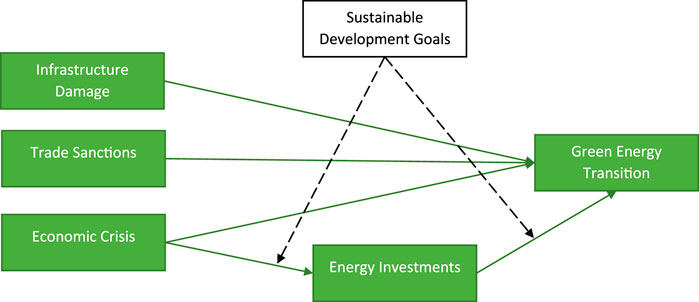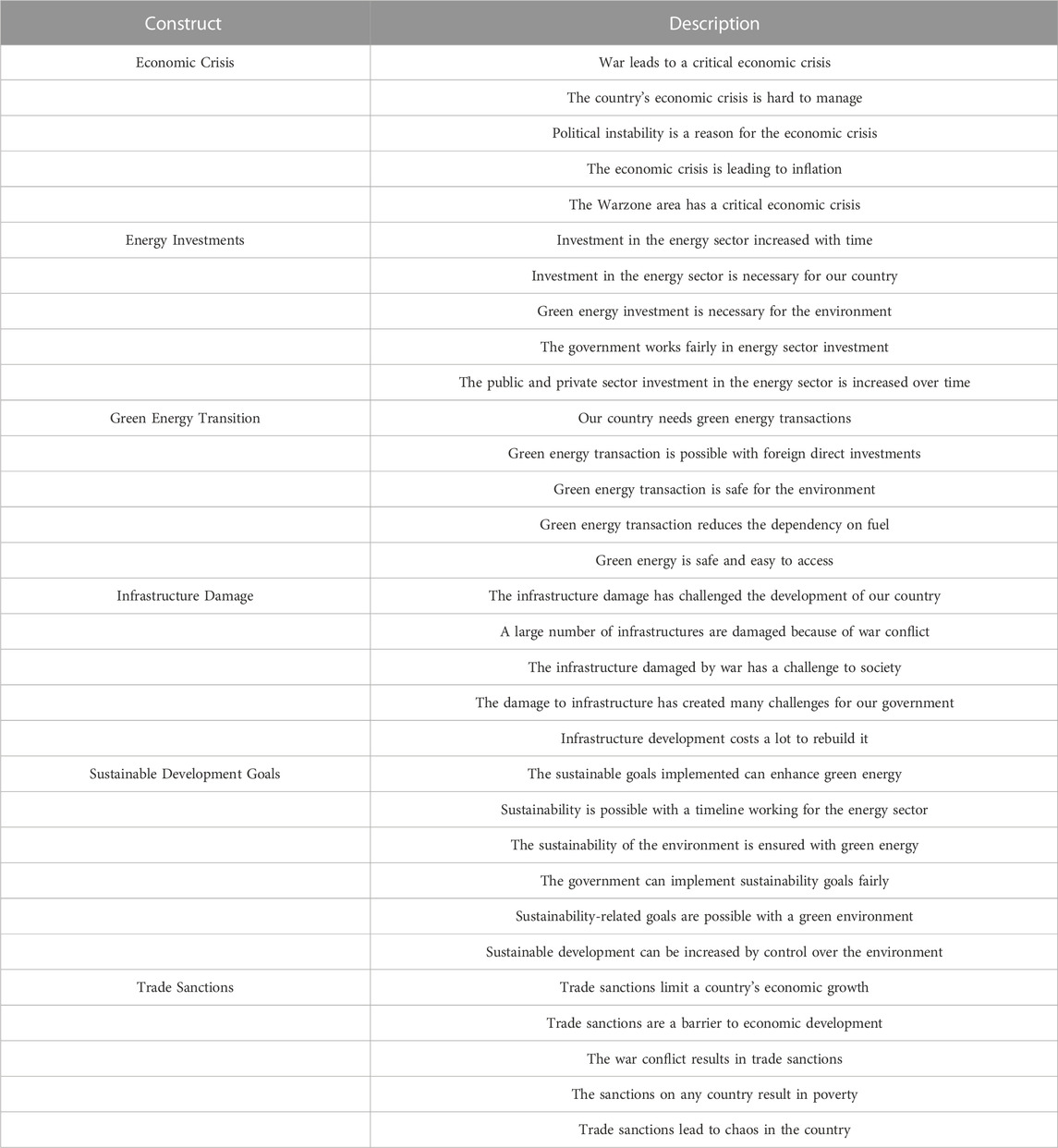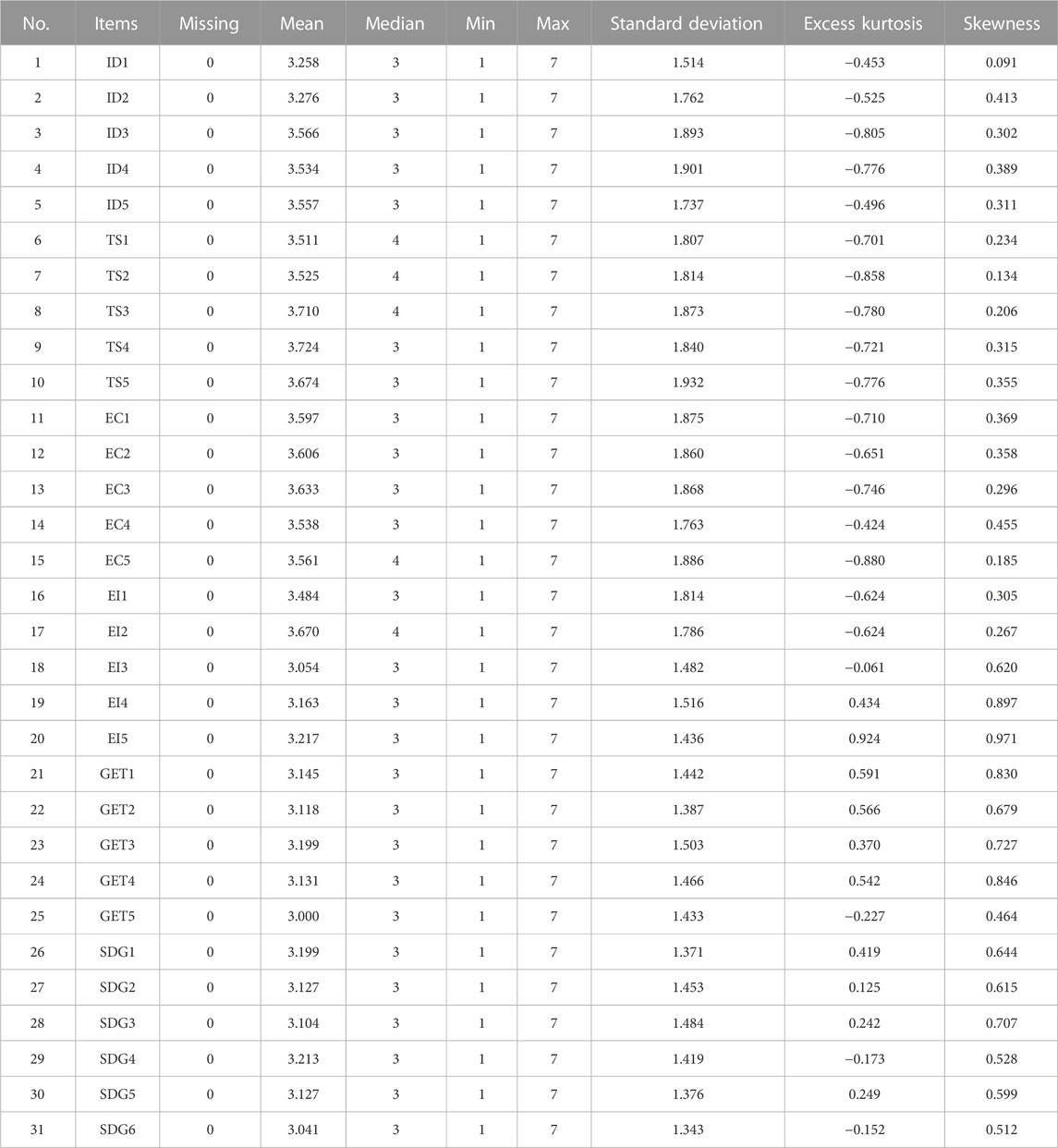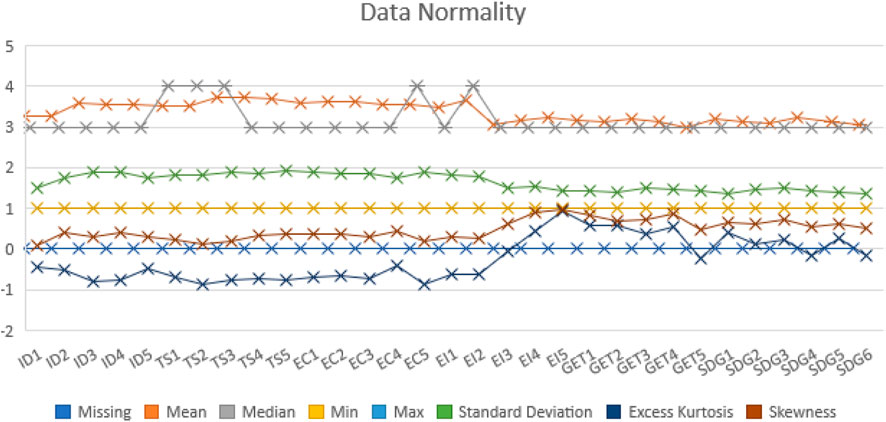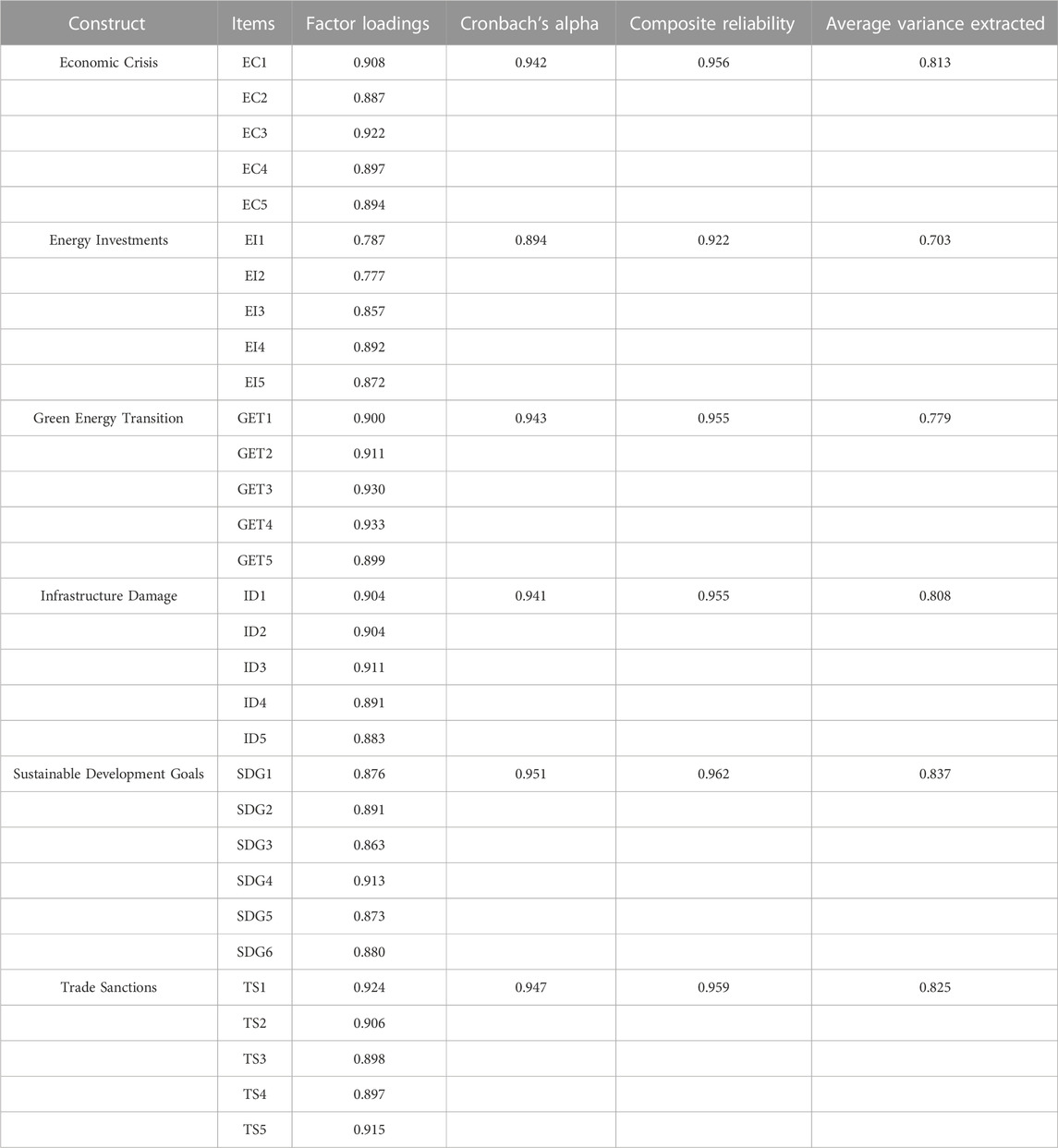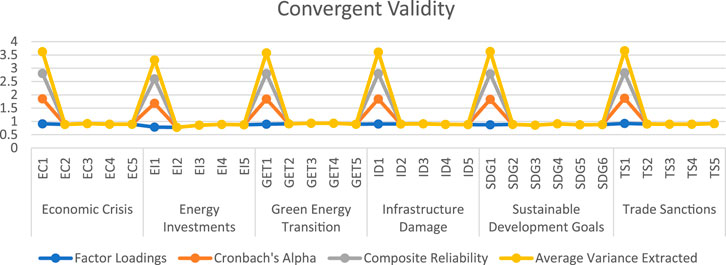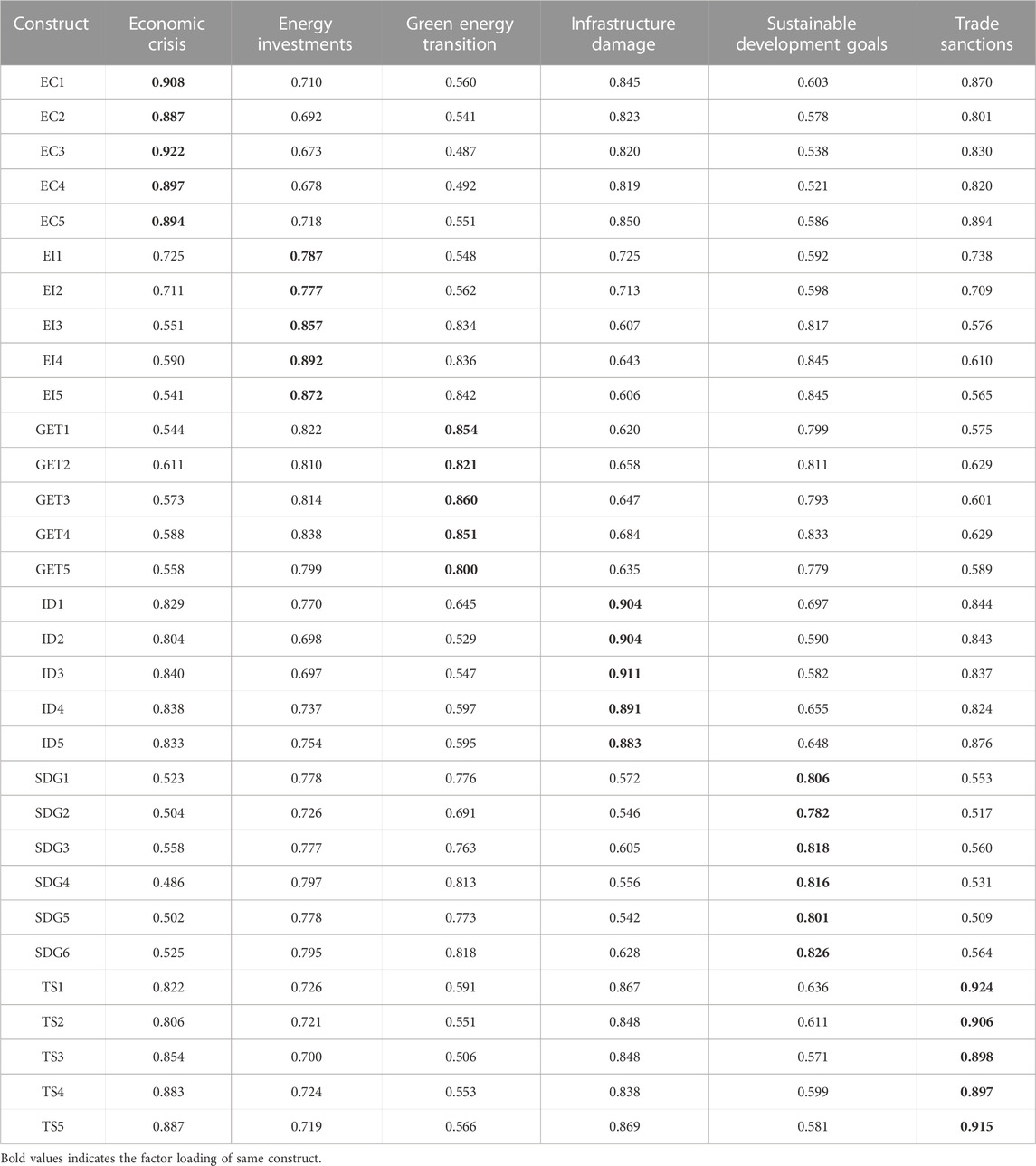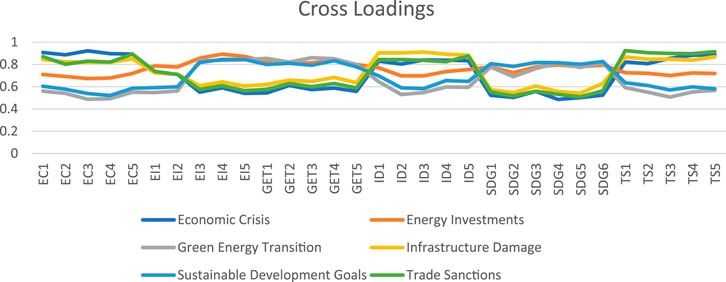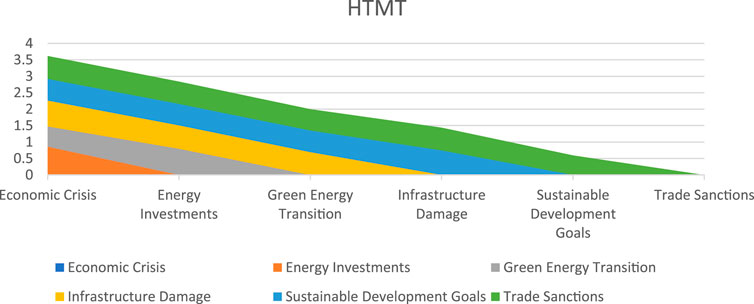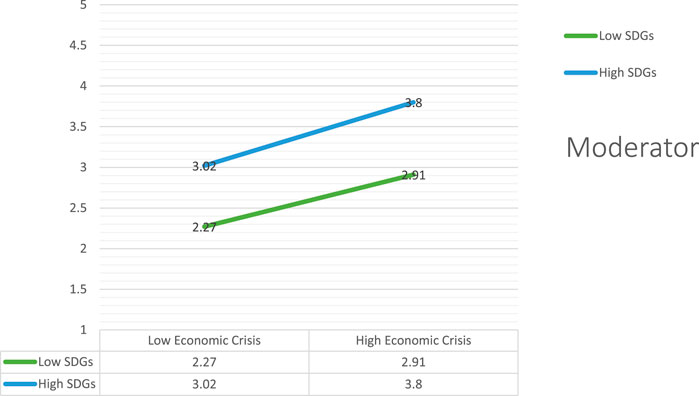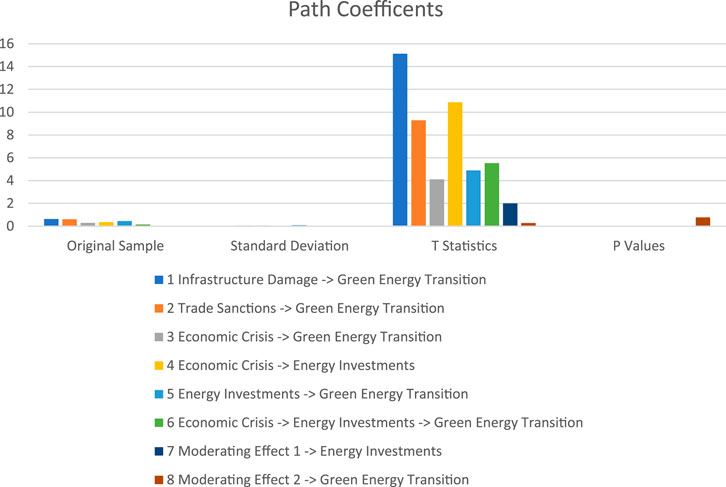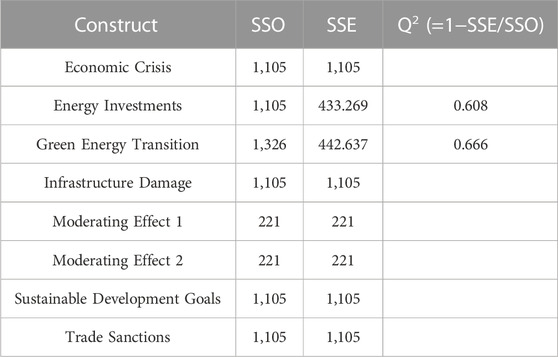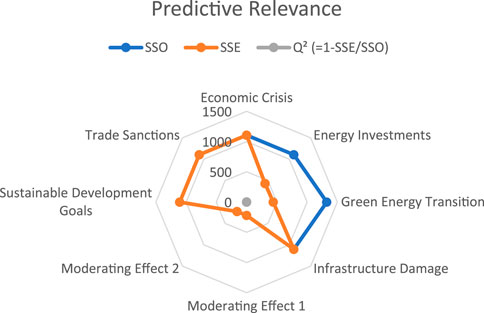- 1School of Economics and Management, Huzhou University, Zhejiang, China
- 2School of Economics and Finance, Massey University, Palmerston North, New Zealand
- 3Muhammad Nawaz Sharif University of Engineering & Technology, Multan, Pakistan
- 4Institute of Business, Management and Administrative Sciences, The Islamia University of Bahawalpur, Bahawalpur, Pakistan
- 5Department of Economics, Lahore College for Women University, Lahore, Pakistan
- 6Department of Environmental Management, National College of Business Administration and Economics, Lahore, Pakistan
The Ukrainian economic crisis began with the start of the war and grew over time. This is because trade between countries was spread out because of problems with the supply chain. However, the energy sector in Ukraine is largely disturbed by this armed conflict. The purpose of this study was to test the impact of infrastructure damage, trade sanctions, the economic crisis, and energy investments in green energy in Ukraine through the lens of sustainable development goals (SGDs). The data is collected from the Ukrainian public, and the sample size for this research is 384. This research has used the structural equation modeling method by using Smart PLS 3 for data analysis. The findings of the study suggest that a green energy transition is possible when the Ukrainian government works on SDGs to manage the economic crisis and increases investments in the energy sector. The moderation of SGDs is considered a way forward for development in Ukraine. The novelty of this research is based on its framework, which is a new addition to a piece of knowledge. This research has extended knowledge by presenting new relationships related to the green energy transition. The limitations of this research are presented in conjunction with future directions that are a reliable way for scholars to contribute further to this area of research.
1 Introduction
The conflict between Russia and Ukraine is not limited to political boundaries; this conflict causes a variety of other societal setbacks (Mbah and Wasum, 2022). A bad economic situation in any country is possible when its aristocracy is involved in invading or fighting with other countries. The Russian invasion of Ukraine has presented the international community with a challenge because the consequences of war are never limited to the borders. The international community is also affected by the Russia-Ukraine conflict as the Ukrainian community is distrusted. A large number of infrastructures are damaged due to political conflict that results in an economic downturn (Gaio et al., 2022). The responsibility of the government is to develop and reliably work on infrastructure development. Community development is possible when reasonable actions are taken according to the Sustainable Development Goals (SDGs). However, the fight between the Russian and Ukrainian armies damaged a lot of infrastructure, and community development became a secondary priority of the government (Davis, 2016). The start of this conflict has changed how the countries work together and how they trade with each other. In the case of Russia and Ukraine, it has changed how they trade with each other, and the political conflicts have become an economic conflict.
The economic crisis in Ukraine emerged over time with the outbreak of war, because the trade between different countries was disturbed due to issues related to the supply chain (Umar et al., 2022). These trade issues restricted the Ukrainian government’s ability to get an appropriate supply of fuel for its energy sector. The development of the energy sector in Ukrainian territory is based on the traditional infrastructure system, which has been badly disturbed by the war. The armed conflicts result in blasts, and the infrastructure developed by the Ukrainian government for its energy supply is disturbed (Bin-Nashwan et al., 2022). Trade sanctions, on the other hand, are critical for the government because Russia’s supportive countries limited their supply and imports with the Ukrainian government. This kind of conflict has led to an energy breakdown in the country (Adekoya et al., 2022). Undeniably, there was no backup system for the sustainability of infrastructure for the energy sector in Ukrainian territory. This challenge emerged over time as the war got worse and the armed conflict continued. The Russian attacks on major cities damaged several roads, buildings, and bridges that are vital to the country’s trade and energy development (Abbassi et al., 2023). The energy plants were also damaged during the conflict by a Russian force and the counterforce of Ukrainian forces.
Developed countries have worked in the green energy sector to make sure that their countries use less energy. Adopting SDGs, which are needed to set the governments on the right path, will help the energy sector move forward (Ben Hassen and El Bilali, 2022). Rich countries have already shifted to the green energy sector, which is necessary for the development and sustainability of the environment. A sustainable environment in any country is necessary to enhance the living standard of the people, but this sustainability is ensured through the actions of the government (Khan et al., 2022a; Khan et al., 2022b; Shen and Hong, 2023). However, poor countries that are largely dependent on bad infrastructure for the development of goals related to sustainability are facing challenges in a time of economic crisis (Alam et al., 2022). Conflicts can be the future of any country, but sustainability is the only way to help countries work in a green way (Khan et al., 2023). If the Ukrainian government worked in a smart way, there would be less damage to the energy infrastructure as a result of the armed conflict (Yousaf et al., 2022). The literature related to the green energy transition in the context of Ukraine is limited. In this way, Nerlinger and Utz. (2022) reported that the Russia-Ukraine conflict appears not to entirely change the investors’ assessment of a possible acceleration of a green energy transition. Furthermore, Saktiawan et al. (2022) reported that European countries have increased the budget for developing and using environmentally friendly energy to remove the dependence on gas and oil energy from Russia. Accordingly, Steffen and Patt. (2022) highlighted that Swiss public support for strong government policies is appropriate for clean energy policy. No doubt, these studies have contributed significant information to knowledge, but there is still a research gap in literature regarding the impact of infrastructure damage, trade sanctions, the economic crisis, and energy investment in relation to the transition to green energy. To add to the body of knowledge with important findings, the new information is needed.
Therefore, the purpose of this research is to test the impact of infrastructure damage, trade sanctions, the economic crisis, and energy investments in green energy transitions in Ukraine through the lens of SGDs. This research’s scope is limited to the green energy transition in Ukraine. The novelty of this research is based on its framework, which is a new addition to a piece of knowledge. This research has used the structural equation modelling method for data analysis on responses collected by Ukrainian respondents. Theoretically, this research has extended knowledge by presenting new relationships related to green energy transitions. Furthermore, the moderation of SGDs is considered a way forward for development in Ukraine. As a result, this research has highlighted potential ways for the Ukrainian government to ensure green energy transitions in light of the SDGs. This research is based on a comprehensive literature review, a framework and hypotheses development. In line with this, the methodology of the study is also described before the data analysis section, and after the data analysis, the discussion and implications of the study are reported with future directions.
2 Review of literature
The Russian invasion of Ukrainian territories presented a different set of challenges. The energy crisis was also faced by the Ukrainian government when the economic crisis started and infrastructure was destroyed (Akter et al., 2011). This research has focused on the relationship between infrastructure damage, trade sanctions, the economic crisis, energy investments, and the green energy transition. Furthermore, the moderating influence of SDGs is also tested in this research model. However, the model of this research is available in Figure 1.
2.1 Hypotheses development
The damage to energy infrastructure is challenging for energy development in any country. The Ukrainian government faced challenges related to energy sector infrastructure damage (Gaio et al., 2022). The rich countries are working on infrastructure development on a large scale to enhance the capacity to produce energy at an appropriate level. The lack of reliability in the energy sector can make it challenging for the government to work on the energy sector and its advancement (Umar et al., 2022). The infrastructure for energy production and the supply of materials related to energy production need to be upgraded for a sustainable mission. The advancement of better infrastructure for energy can enhance the energy sector’s development.
Trade sanctions are a challenge for any country trying to improve its public living standard (Davis, 2016). These trade sanctions can reduce imports and exports, which is a challenge for the energy sector. Furthermore, stable economies even face the consequences of trade sanctions and different kinds of economic crises. Better economic goals can be developed when a large investment in the energy sector is available in any country (Abbassi et al., 2023). Sanctions imposed by powerful countries or international organizations pose a challenge to the country’s development. The Ukrainian energy sector faced trade-related problems when supply was affected by Russian aggression.
The economic crisis in Ukraine led to different kinds of challenges. The government of Ukraine faces different kinds of economic consequences when involved in armed conflict with Russia (Alam et al., 2022). The economic crisis also negatively affected the energy sector because the supply chain and other dimensions of work were at stake (Yousaf et al., 2022). The role of any government is to enhance its operations for the delivery of sustainable energy to the community. However, the case of Ukraine was different because the economy was affected due to war-related conflicts, and the sustainability of the work was badly affected to produce energy.
The economic crisis is not suitable for the working performance of any country. Investment in the energy sector can enhance the capacity of energy production in any country (Adekoya et al., 2022). Rich countries rarely face economic challenges, and they can bitterly develop their attitude towards the development of the energy sector. The reliability of the energy sector’s efficiency is based on infrastructure development and better investment (Ben Hassen and El Bilali, 2022). However, Ukraine faced challenges related to the economy, and no firm was ready to invest in the energy sector to enhance its work to a higher level. Economic stability is possible with the foreign investment that is required in the energy sector of Ukraine.
Investment in the energy sector is a reliable way of working. Furthermore, investments in green energy have enhanced the efficiency and effectiveness of different countries work (Yousaf et al., 2022). The adaptability of the new vision for green energy is a reliable way to enhance the energy sector’s capacity in any country. The developed world has megaprojects for energy sector transition. The availability of resources is hard to understand, and the development of the infrastructure sector advances (Ahmed et al., 2022). Moreover, the energy sector’s reliable investment according to SDGs can boost the performance of the energy sector in any country. The ability to invest is one of the most important things for improving the energy sector in Ukraine.
Investment in the energy sector is a reliable way of working. Those countries that have sustainability in their working practices have large foreign direct investments in green energy production. However, the conflicts between Russia and Ukraine led to an economic crisis in the country that was a challenge to the country’s sustainable advancement (Khudaykulova et al., 2022). With economic stability, the reliability of the work for improving the advancement of the energy sector is possible. The availability of investments in the energy sector can enhance its performance to an advanced level with the sustainable development of the sector (Beraich et al., 2022). Accordingly, energy sector development is possible with the energy transition.
SDGs are used to improve the different sectors of government working for a better future. Sustainability in the economy is a possible way to improve the energy sector (Charap and Colton, 2018). However, investments in the energy sector should be based on sustainable development methods. The only way to help achieve goals in the energy sector is to ensure the long-term viability of investments. Less focus on SDGs can result in negative consequences because the smart goals are not met by the government to improve its performance productively (Charap and Colton, 2018). The availability of the goals and the workings of the government can be reliable when the economic situation is better in Ukraine.
The SDGs are to improve the environment through energy efficiency. The countries that have an appropriate focus on the development of the environment have reliable working attitudes (Bin-Nashwan et al., 2022). The availability of resources may be a more effective means of achieving SDGs in the energy sector. However, green investment is possible with the reliable work of the government in the energy sector. The Ukrainian government is required to influence foreign firms for smart investment in the green energy sector (Shen and Hong, 2023). The transition of energy from traditional to green modes can improve the workings of the Ukrainian government with less dependency on traditional energy production plants.
H1. There is a relationship between infrastructure damage and the green energy transition.
H2. There is a relationship between trade sanctions and the green energy transition.
H3. There is a relationship between the economic crisis and the green energy transition.
H4. There is a relationship between economic crisis and energy investments.
H5. There is a relationship between energy investments and green energy transition.
H6. There is the mediation of energy investments between the economic crisis and the green energy transition.
H7. There is a moderation of sustainable development goals between economic crisis and energy investments.
H8. There is a moderation of sustainable development goals between energy investments and green energy transition.
3 Methodology
3.1 Measurement development
The study is based on issues related to green energy transactions, but the context of this research is the war between Russia and Ukraine. The research that has already been done is looked at very carefully, and the measurements made by different studies are checked. But no scale was thought to be a good fit for this research because of the way it was used. Therefore, the scale development process is considered appropriate for this research. This process recommended by O'Brien and Toms. (2010) is used in the research for the development of the items. Furthermore, the existing literature is reviewed in detail, explaining the relationship between different variables in the conceptual framework. This literature is considered a reliable way to develop the scale. The definitions for each construct are taken, and the operationalization of the variables is also considered. Each key term is understood in its context, and the focus group discussion methodology is adopted for it. Hence, a pool of items based on a 7-point Likert scale is developed for each construct to determine the valid scale with a face validity test initially.
Experts from various universities were contacted to provide critical feedback on the scale items. In this way, the recommendations of the experts are used for scaled-down development. The modifications suggested by the experts are also considered in the scale development process. Furthermore, after the addition of all modifications and operationalization, including face validity, a data set on the scale is collected by 45 experts. This data is used for exploratory factor analysis to determine the scale items statistically. The statistical data initially approved the validity of the items, but six items achieved factor loadings less than 0.60. Therefore, these items were deleted. Furthermore, the validity of the scale is again confirmed by another group of experts, who endorse the context and content of the scale as valid for data collection. However, the confirmatory factor analysis test is also conducted on a data set to investigate the correlation between the measurement scales. The results of the confirmatory factor analysis were also approved for scale validity. As a result, the study has developed six items: one for the economic crisis, five for energy investments, five for green energy transactions, five for infrastructure damage, six for sustainable development goals, and five for trade sanctions. The scale developed for this research is available in Table 1.
3.2 Data collection and statistical tool
The data for this research was collected from the respondents, who are citizens of Ukraine. On 1 January 2023, the United Nations estimated the Ukrainian population to be 34.1 million, with record low birth rates (United Nations Report, 2023). As the population is known and above 10, 000, 00, therefore, according to Krejcie and Morgan Table, the appropriate sample for this research is 384 (Krejcie and Morgan, 1970). However, 500 questionnaires were distributed for data collection because it is challenging to distribute 384 questionnaires exactly and collect data on them. The respondents were informed about the purpose of this research. They voluntarily participated in the data collection method. The demographic information of the respondents is confidential. However, 251 of them were women and 133 were men, belonging to different social statuses and age groups. However, the respondents’ education was also different, but they were all educated. The total population of the study was known, but due to the unavailability of any sample frame, convenience sampling was utilized. Furthermore, the research has used the most recommended statistical tool, “Smart PLS 3.0.” (Hair et al., 2012) for data analysis to determine the measurement model assessment, structural model assessment, and predictive relevance. This research is significant because it has developed the scale items and introduced the structural equation model in this area of knowledge.
4 Findings and data analysis
Skewness and kurtosis findings are used to assess data normality. The data is collected by coding the responses into Smart PLS 3.0. The skewness values for significant normality should not be greater than +1 or less than −1 (Bai and Ng, 2005). Accordingly, the kurtosis values for data normality should not be more than +1 or less than −1 (Kim and White, 2004). In this way, the research findings available in Table 2 and Figure 2 achieved a significant threshold for skewness and kurtosis values. As a result, the data collected for this study is normal and contains no missing values.
4.1 Convergent validity
The outcomes of convergent validity are used to test the reliability of the data. The factors considered for this test are Cronbach’s alpha, composite reliability, average variance extracted, and factor loadings. The factor loadings above 0.60 are significant (Peterson, 2000). Furthermore, the composite reliability of more than 0.70 is significant (Alarcón et al., 2015), and also Cronbach’s alpha of more than 0.70 is significant (Taber, 2018). Accordingly, the average variance extracted values more than 0.50 are significant (Alarcón et al., 2015). The reported data in Table 3 and Figure 3 highlight that all the thresholds of significance were achieved by this research. Hence, the reliability and validity indicators for this research data are achieved.
4.2 Discriminant validity
The discriminant validity of this research data is tested. Accordingly, the findings of Smart PLS are used for it. There are two different methods of discriminant validity tested in this research. Firstly, the cross-loading is tested, which is significant when the loadings of any construct’s indicators are greater than the loadings of other construct’s indicators that are correlated with it (Li et al., 2020). The reported data in Table 4 and Figure 4 is accepted for cross-loadings.
Furthermore, the discriminant validity of the research data is tested using the heteritrait-monotrait (HTMT) method. The significance of discriminant validity is possible when the values taken by the HTMT model are less than 0.90 (Roemer et al., 2021). The reported data in Table 5 and Figure 5 show that this research also achieved the HTMT method of discriminant validity. Hence, the data for this research has appropriate discriminant validity.
4.3 Structural equation model
The structural equation model is used for data analysis to test the path coefficients. The significance of path coefficients is checked with t > 1.96 and p < 0.50 (Hair et al., 2012). The results demonstrated that the impact of infrastructure damage on the green energy transition is confirmed by “p = 0.” Similarly, the results demonstrated that the impact of trade sanctions on the green energy transition is confirmed by “p = 0.” Furthermore, the results demonstrated that the impact of the economic crisis on the green energy transition is confirmed by “p = 0.” Accordingly, the results demonstrated that the impact of trade sanctions on energy investments is confirmed by “p = 0.” Likewise, the results demonstrated that the impact of energy investments on the green energy transition is confirmed by “p = 0.” The mediation of energy investments is confirmed between the economic crisis and the green energy transition with “p = 0.” However, the moderation of SDGs is confirmed between the economic crisis and energy investments: “p = 0.046.” In this way, the moderation of SDGs positively strengthens the relationship between the economic crisis and energy investments. The results of this moderating hypothesis are also highlighted in Figure 6. Meanwhile, the moderation of SDGs between energy investments and green energy transition is rejected: “p = 0.786.” The data for these paths are reported in Table 6 and Figure 7.
4.4 Predictive relevance
The model strength and predictive relevance are tested with Q2. The PLS Predictive Relevance tool is used for this finding. The significance of predictive relevance is ensured when the Q2 is greater than 0 (Akter et al., 2011). The reported data in Table 7 and Figure 8 demonstrated that this study has 66% predictive relevance, which is strong. Hence, the model of this research has appropriate predictive relevance.
5 Discussion
The study objective is significantly achieved by its findings related to the green energy transition. However, the findings of this study are novel in terms of knowledge and literature. The research hypotheses based on different paths are tested with a structural equation model. The relationship based on H1 between infrastructure damage and green energy transactions is confirmed. Furthermore, the existing literature also supports this hypothesis. Any country’s efforts to improve its energy industry face difficulties due to damage to the energy infrastructure (Abbassi et al., 2023). The destruction of the infrastructure in the energy industry presented difficulties for the Ukrainian administration. Wealthy nations are investing heavily in infrastructure development to increase their ability to produce energy at the proper level (Ben Hassen and El Bilali, 2022). It may be difficult for the government to focus on the energy sector’s advancement given its declining reliability. It is essential to modernize the energy production infrastructure and the supply of materials associated with energy production to achieve sustainability. The development of the energy sector may be aided by the advancement of better infrastructure.
Accordingly, the relationship based on H2, between trade sanctions and green energy transactions is confirmed. Also, the existing literature supports this hypothesis. The trade sanctions make it difficult for any nation to raise the standard of living for its people. These trade penalties may lessen imports and exports, which might be problematic for the energy sector (Yousaf et al., 2022). The effects of trade sanctions and other economic crises are also felt in stable economies. When significant investment in the energy industry is available in every nation, greater economic goals can be developed (Davis, 2016). The imposition of sanctions by strong nations or any organization of nations is a difficult path for a country’s progress. commercial issues in the Ukrainian energy sector when Russian aggression impacted supply.
Thirdly, the relationship based on H3 between the economic crisis and green energy transactions is confirmed. Still, the existing literature also supports this hypothesis. Ukraine’s financial downturn brought up a variety of difficulties. When engaged in armed combat with Russia, the Ukrainian government faces a variety of economic repercussions (Umar et al., 2022). Since the supply chain and other aspects of work were in jeopardy, the economic crisis also had a detrimental impact on the energy industry. Any government’s job is to optimize operations so that the community can receive sustainable energy (Charap and Colton, 2018). But the situation in Ukraine was different because of the war, which hurt the country’s economy and made it much harder for the energy production industry to work.
Fourth, the relationship between H4 and energy investments during the economic crisis is proven to be true. Furthermore, the existing literature also supports this hypothesis. No country’s productivity can be supported by the current economic situation. Any country’s capability for energy production can be increased by investments in the energy sector (Beraich et al., 2022). Rich nations rarely experience economic hardships, and as a result, their attitudes toward the growth of the energy sector might become harsh. Infrastructure development with better investment is the foundation for the energy sector’s dependability and effectiveness (Charap and Colton, 2018). Although Ukraine was experiencing economic difficulties, no company was willing to invest in the energy sector to raise the sector’s productivity. Ukraine’s energy sector, which is important for the country’s economy, needs money from outside the country.
According to H5, there is a link between energy investments and transactions that use green energy. Furthermore, the existing literature also supports this hypothesis. Participation in the energy industry is a reliable method of operation. Additionally, the effectiveness and efficiency of various nations’ efforts have increased thanks to investments in green energy (Khudaykulova et al., 2022). A proven technique to increase the capacity of any nation’s energy sector is through the flexibility of the new vision for green energy. Megaprojects for the transformation of the energy industry exist in wealthy nations. It is difficult to comprehend why resources are less accessible and why the infrastructure industry is developing more quickly (Karolewski and Cross, 2017). Additionally, consistent investments in the energy sector following the SDGs can improve the performance of the sector in any nation. The improvement of Ukraine’s energy sector depends critically on the availability of investment resources.
The mediation relationship based on H6 is also accepted, as is the mediation of energy investments between the economic crisis and green energy transactions. Indeed, this relationship is new to our knowledge, but the existing studies support it (Adekoya et al., 2022). The most reliable method of operation is to invest in the energy sector. Sustainability-oriented nations receive significant foreign direct investments for the generation of green energy. However, the hostilities between Russia and Ukraine caused an economic crisis in the nation that made it difficult for the country to progress sustainably (Ahmed et al., 2022). With economic stability, it will be more reliable to work towards enhancing the energy sector’s advancement. With the growth of the energy industry in a sustainable fashion, the availability of investments can advance its performance to a higher level. As a result, the energy transition makes the development of the energy industry possible.
Additionally, the moderation relationship based on H7 is also accepted, and the moderation of SDGs between economic crisis and energy investments is also confirmed. This relationship is certainly novel, but existing research backs it up. The SDGs are utilized to strengthen the various government departments striving for a brighter future (Shen and Hong, 2023). Improving the energy sector may be achievable through economic sustainability. However, sustainable development methods should be the foundation for all energy sector investments. The only method that can assist in achieving objectives in the energy sector is the dependability of investments made sustainably (Alam et al., 2022). Less attention paid to the SDGs could have a negative impact because the government would not be able to achieve the smart goals that would have helped it enhance its performance. When Ukraine’s economic situation is better, the goals’ accessibility and the government’s operation can be trusted.
However, the moderation relationship based on H8 is not accepted, and the moderation of SDGs between energy investments and green energy transactions is rejected. The SDGs call for increased energy efficiency to improve the environment (Gaio et al., 2022). Countries with good work ethics are those that put the right amount of focus on the development of the environment. In the energy industry, it may be easier to reach the SDGs if we have the resources to do so. However, green investments are feasible because of the government’s dependable performance in the energy industry (Bin-Nashwan et al., 2022). The Ukrainian government must persuade international businesses to make wise investments in the green energy industry. By switching from traditional to green ways of making energy, the Ukrainian government can run more efficiently because it will not have to rely as much on traditional energy sources.
6 Conclusion
In a nutshell, this research showed that it is the Ukrainian government’s job to build infrastructure in a way that is sustainable. Also, this kind of infrastructure growth is possible if the Ukrainian government takes reasonable steps to help with the transition to green energy. In the same way, this research found that the transition to green energy is possible if the Ukrainian government works on the Sustainable Development Goals (SDGs) to deal with the economic crisis and get more money invested in the energy sector. Indeed, a responsible government can work in a fair way to remove all kinds of trace barriers. So, the Ukrainian government can work toward a green energy transition by improving infrastructure, making the economy better, and investing in energy.
7 Implications, limitations, and future directions
The novelty of this research is based on its framework, which is a new addition to knowledge. This research has extended knowledge by presenting new relationships related to green energy transactions. The moderation of SGDs is considered a way forward for development in Ukraine. This research has contributed to the knowledge that the green energy transition is influenced by infrastructure damage, the economic crisis, trade sanctions, and energy investments. Furthermore, this research revealed the mediation relationship of energy investments between the economic crisis and green energy transactions. Accordingly, this research has enhanced the literature on the moderating relationship of SDGs with economic crises and energy investments. These additions to the body of knowledge are novel contributions to this research. Furthermore, this research has reliable practical implications for the Ukrainian government to improve its work on green energy transactions. The study demonstrated that the Ukrainian government is required to work on the implementation of SDGs and that the green energy investment method should be adopted for it.
Foreign direct investment in green energy can help improve the performance of government departments and keep the energy sector’s progress going for a long time. So, the government of Ukraine has to build infrastructure for the energy sector in a green way so that the community might be able to use green energy. Also, the Ukrainian government needs to figure out how to deal with the economic crisis in a way that will work for the long term. This research has certain limitations that are required to be addressed by future studies. Initially, the study developed a scale that was new in nature and considered valid for this research through confirmatory factor analysis and exploratory factor analysis. However, the scholars are required to test this scale with another set of samples to determine its further validity. Accordingly, the model developed by this research has determined different factors for green energy transactions, but it has not considered the factor of foreign direct investment in this model. Therefore, the scholars are wishing to determine the impact of foreign direct investment on green energy transactions in Ukraine. As a result, scholars will address these limitations of this research in future research works.
Data availability statement
Data associated with this study is available from the corresponding author upon a reasonable request.
Ethics statement
Ethical review and approval was not required for the study on human participants in accordance with the local legislation and institutional requirements. The study did not involve humans as subjects. However, the participants were informed and consent was obtained before data collection.
Author contributions
Conceptualization, HT, AJK and AM; Methodology, AJK and WUH; Project administration, HT; Validation, HT, HB and TA; Visualization, TA; Writing—original draft, HT, AJK and AM; Writing—review and editing, HB and TA; All authors have read and agreed to the published version of the manuscript.
Conflict of interest
The authors declare that the research was conducted in the absence of any commercial or financial relationships that could be construed as a potential conflict of interest.
Publisher’s note
All claims expressed in this article are solely those of the authors and do not necessarily represent those of their affiliated organizations, or those of the publisher, the editors and the reviewers. Any product that may be evaluated in this article, or claim that may be made by its manufacturer, is not guaranteed or endorsed by the publisher.
References
Abbassi, W., Kumari, V., and Pandey, D. K. (2023). What makes firms vulnerable to the Russia–Ukraine crisis? J. Risk Finance 24 (1), 24–39. doi:10.1108/jrf-05-2022-0108
Adekoya, O. B., Oliyide, J. A., Yaya, O. S., and Al-Faryan, M. A. S. (2022). Does oil connect differently with prominent assets during war? Analysis of intra-day data during the Russia-Ukraine saga. Resour. Policy 77, 102728. doi:10.1016/j.resourpol.2022.102728
Ahmed, S., Hasan, M. M., and Kamal, M. R. (2022). Russia–Ukraine crisis: The effects on the European stock market. Eur. Financ. Manag., 1–41. doi:10.1111/eufm.12386
Akter, S., D'ambra, J., and Ray, P. (2011). “An evaluation of PLS based complex models: The roles of power analysis, predictive relevance and GoF index,” in 17th americas conference on information systems (Detroit, Michigan, USA: AMCIS).
Alam, M. K., Tabash, M. I., Billah, M., Kumar, S., and Anagreh, S. (2022). The impacts of the Russia–Ukraine invasion on global markets and commodities: A dynamic connectedness among G7 and BRIC markets. J. Risk Financial Manag. 15 (8), 352. doi:10.3390/jrfm15080352
Alarcón, D., Sánchez, J. A., and De Olavide, U. (2015). Assessing convergent and discriminant validity in the ADHD-R IV rating scale: User-written commands for Average Variance Extracted (AVE), Composite Reliability (CR), and Heterotrait-Monotrait ratio of correlations (HTMT). Paper presented at the Spanish STATA meeting.
Bai, J., and Ng, S. (2005). Tests for skewness, kurtosis, and normality for time series data. J. Bus. Econ. Statistics 23 (1), 49–60. doi:10.1198/073500104000000271
Ben Hassen, T., and El Bilali, H. (2022). Impacts of the Russia-Ukraine war on global food security: Towards more sustainable and resilient food systems? Foods 11 (15), 2301. doi:10.3390/foods11152301
Beraich, M., Amzile, K., Laamire, J., Zirari, O., and Fadali, M. A. (2022). Volatility spillover effects of the US, European and Chinese financial markets in the context of the Russia–Ukraine conflict. Int. J. Financial Stud. 10 (4), 95. doi:10.3390/ijfs10040095
Bin-Nashwan, S. A., Hassan, M. K., and Muneeza, A. (2022). Russia–Ukraine conflict: 2030 agenda for SDGs hangs in the balance. Int. J. Ethics Syst. doi:10.1108/ijoes-06-2022-0136
Charap, S., and Colton, T. J. (2018). Everyone loses: The Ukraine crisis and the ruinous contest for post-Soviet. Eurasia: Routledge.
Davis, C. M. (2016). The Ukraine conflict, economic–military power balances and economic sanctions. Post-Communist Econ. 28 (2), 167–198. doi:10.1080/14631377.2016.1139301
Gaio, L. E., Stefanelli, N. O., Júnior, T. P., Bonacim, C. A. G., and Gatsios, R. C. (2022). The impact of the Russia-Ukraine conflict on market efficiency: Evidence for the developed stock market. Finance Res. Lett. 50, 103302. doi:10.1016/j.frl.2022.103302
Hair, J. F., Sarstedt, M., Ringle, C. M., and Mena, J. A. (2012). An assessment of the use of partial least squares structural equation modeling in marketing research. J. Acad. Mark. Sci. 40 (3), 414–433. doi:10.1007/s11747-011-0261-6
Karolewski, I. P., and Cross, M. a. K. D. (2017). The EU's power in the Russia–Ukraine crisis: Enabled or constrained? JCMS J. Common Mark. Stud. 55 (1), 137–152. doi:10.1111/jcms.12446
Khan, A. J., Hameed, W. U., Ahmed, T., Iqbal, J., Aplin, M. J., and Leahy, S. (2023). Green behaviors and innovations: A green hrm perspective to move from traditional to sustainable environmental performance. Empl. Responsib. Rights J. 2023, 1–18. doi:10.1007/s10672-023-09443-8
Khan, A. J., Ul Hameed, W., Iqbal, J., Shah, A. A., Tariq, M. A. U. R., and Ahmed, S. (2022b). Adoption of sustainability innovations and environmental opinion leadership: A way to foster environmental sustainability through diffusion of innovation theory. Sustainability 14 (21), 14547. doi:10.3390/su142114547
Khan, A. J., Ul Hameed, W., Iqbal, J., Shah, A. A., Tariq, M. A. U. R., and Bashir, F. (2022a). Green HRM and employee efficiency: The mediating role of employee motivation in emerging small businesses. Front. Environ. Sci. 10, 2233. doi:10.3389/fenvs.2022.1044629
Khudaykulova, M., Yuanqiong, H., and Khudaykulov, A. (2022). Economic consequences and implications of the Ukraine-Russia war. Int. J. Manag. Sci. Bus. Adm. 8 (4), 44–52. doi:10.18775/ijmsba.1849-5664-5419.2014.84.1005
Kim, T. H., and White, H. (2004). On more robust estimation of skewness and kurtosis. Finance Res. Lett. 1 (1), 56–73. doi:10.1016/s1544-6123(03)00003-5
Krejcie, R. V., and Morgan, D. W. (1970). Determining sample size for research activities. Educational and psychological measurement 30 (3), 607–610.
Li, Y., Wen, Z., Hau, K. T., Yuan, K. H., and Peng, Y. (2020). Effects of cross-loadings on determining the number of factors to retain. Struct. Equ. Model. A Multidiscip. J. 27 (6), 841–863. doi:10.1080/10705511.2020.1745075
Mbah, R. E., and Wasum, D. F. (2022). Russian-Ukraine 2022 war: A review of the economic impact of Russian-Ukraine crisis on the USA, UK, Canada, and europe. Adv. Soc. Sci. Res. J. 9 (3), 144–153. doi:10.14738/assrj.93.12005
Nerlinger, M., and Utz, S. (2022). The impact of the Russia-Ukraine conflict on the green energy transition–A capital market perspective. Technical Paper. Swiss Finance Institute Research Paper.
O'Brien, H. L., and Toms, E. G. (2010). The development and evaluation of a survey to measure user engagement. J. Am. Soc. Inf. Sci. Technol. 61 (1), 50–69. doi:10.1002/asi.21229
Peterson, R. A. (2000). A meta-analysis of variance accounted for and factor loadings in exploratory factor analysis. Mark. Lett. 11 (3), 261–275. doi:10.1023/a:1008191211004
Roemer, E., Schuberth, F., and Henseler, J. (2021). HTMT2–an improved criterion for assessing discriminant validity in structural equation modeling. Industrial Manag. data Syst. 12, 2637–2650. doi:10.1108/IMDS-02-2021-0082
Saktiawan, B., Toro, M. J. S., and Saputro, N. (2022). The impact of the Russia-Ukrainian war on green energy financing in Europe. IOP Conf. Ser. Earth Environ. Sci. 1114, 012066. doi:10.1088/1755-1315/1114/1/012066
Shen, L., and Hong, Y. (2023). Can geopolitical risks excite Germany economic policy uncertainty: Rethinking in the context of the Russia-Ukraine conflict. Finance Res. Lett. 51, 103420. doi:10.1016/j.frl.2022.103420
Steffen, B., and Patt, A. (2022). A historical turning point? Early evidence on how the Russia-Ukraine war changes public support for clean energy policies. Energy Res. Soc. Sci. 91, 102758. doi:10.1016/j.erss.2022.102758
Taber, K. S. (2018). The use of Cronbach’s alpha when developing and reporting research instruments in science education. Res. Sci. Educ. 48 (6), 1273–1296. doi:10.1007/s11165-016-9602-2
Umar, Z., Polat, O., Choi, S. Y., and Teplova, T. (2022). The impact of the Russia-Ukraine conflict on the connectedness of financial markets. Finance Res. Lett. 48, 102976. doi:10.1016/j.frl.2022.102976
Keywords: green energy transition, energy investments, trade sanctions, economic crisis, infrastructure damage, sustainable development goals
Citation: Tang H, Maqbool A, Khan AJ, Ul Hameed W, Batool H and Ahmed T (2023) The moderating role of sustainable development goals in reviving the economy through green initiatives. Front. Environ. Sci. 11:1180479. doi: 10.3389/fenvs.2023.1180479
Received: 06 March 2023; Accepted: 06 April 2023;
Published: 14 April 2023.
Edited by:
Fiza Qureshi, University of Southampton Malaysia, MalaysiaReviewed by:
Ikramuddin Junejo, SZABIST Hyderabad Campus, PakistanElchin Suleymanov, Baku Enginering University, Azerbaijan
Copyright © 2023 Tang, Maqbool, Khan, Ul Hameed, Batool and Ahmed. This is an open-access article distributed under the terms of the Creative Commons Attribution License (CC BY). The use, distribution or reproduction in other forums is permitted, provided the original author(s) and the copyright owner(s) are credited and that the original publication in this journal is cited, in accordance with accepted academic practice. No use, distribution or reproduction is permitted which does not comply with these terms.
*Correspondence: Ali Junaid Khan, SnVuYWFpZGtoYW5AeWFob28uY29t
 Honglei Tang1,2
Honglei Tang1,2 Asifa Maqbool
Asifa Maqbool Ali Junaid Khan
Ali Junaid Khan Waseem Ul Hameed
Waseem Ul Hameed Hafsah Batool
Hafsah Batool